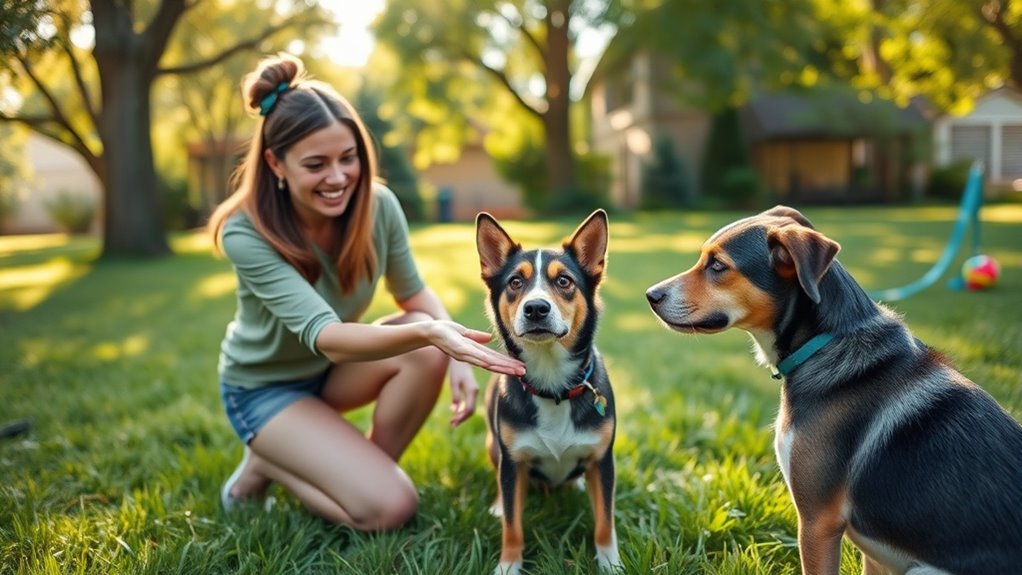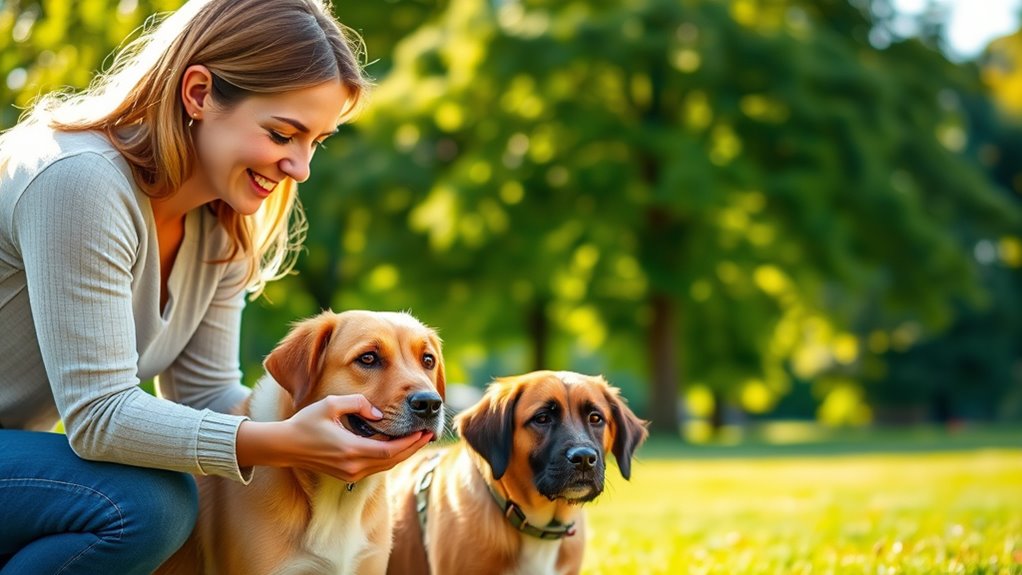When socializing a rescue dog, start slowly and always prioritize patience. Use controlled environments like quiet parks to introduce new people and other animals gradually. Keep your dog leashed until you feel confident it can handle off-leash situations safely. Offer plenty of positive reinforcement with treats and praise, and avoid forcing interactions. Staying calm and consistent helps your dog build trust and confidence over time. Keep going, and you’ll discover even more effective ways to help your rescue thrive.
Key Takeaways
- Introduce your rescue dog gradually to new people and environments, allowing it to acclimate at its own pace.
- Use positive reinforcement, like treats and praise, to encourage calm behavior during social interactions.
- Keep initial socialization sessions short and supervised to prevent overwhelm and build confidence gradually.
- Observe body language closely to identify signs of stress or discomfort, adjusting activities accordingly.
- Maintain consistency and patience, celebrating small progress to foster trust and improve social skills over time.

Bringing a rescue dog into your home is just the first step—helping them feel comfortable and confident around new people and animals is essential for a successful shift. One of the best ways to do this is by exposing your dog to controlled social situations, like visits to the dog park. But before you head out, it’s crucial to understand dog park etiquette. Respect the rules, keep your dog on a leash until you’re sure it’s safe to let them off, and always clean up after them. Watching your dog interact with others can be a great way to build their confidence, but it’s important to monitor their behavior closely. If your rescue dog is nervous or overwhelmed, don’t force interactions; instead, give them time to acclimate at their own pace. Over time, positive experiences at the park can substantially improve their social skills and reduce anxiety around other dogs. Additionally, understanding dog park etiquette can prevent misunderstandings and ensure a positive experience for everyone involved.
Leash training techniques play a essential role in socialization, especially for a rescue dog that might initially be fearful or reactive. Start by establishing a reliable way to keep your dog focused on you, using treats and positive reinforcement. Practice walking on a loose leash in low-distraction environments, gradually introducing more stimulating surroundings as your dog becomes more comfortable. When you visit new places or meet other dogs, keep a firm but gentle hold on the leash. This helps prevent unwanted interactions, especially if your dog is still learning proper social cues. If your dog pulls or reacts aggressively, calmly redirect their attention with treats or commands. Consistency is key—every walk, every outing should follow the same rules so your dog feels secure and understands what’s expected. Over time, leash training techniques will help your dog feel more confident in unfamiliar environments and enable safer, more enjoyable social interactions.
Socializing a rescue dog isn’t a one-and-done process; it takes patience, consistency, and awareness. By practicing good dog park etiquette and reinforcing leash training techniques, you lay the foundation for your dog to become more comfortable and well-adjusted. Remember, every positive experience, no matter how small, contributes to their growth. Stay calm and patient, and celebrate the progress your dog makes along the way. With time and persistence, your rescue dog will learn to navigate social settings with confidence, making outings more enjoyable for both of you. The goal is for your dog to see new environments and other animals as safe, fun, and rewarding, transforming their initial fears into trust and curiosity.
Frequently Asked Questions
How Long Does It Typically Take for a Rescue Dog to Socialize?
The time it takes for a rescue dog to socialize varies, but it generally depends on the dog’s past experiences and your training techniques. During the adoption process, you’ll notice gradual progress as you build trust and confidence. Stay patient, consistent, and positive. Socialization can take weeks or months, so keep practicing and providing a safe environment. Your dedication helps your dog feel secure and comfortable around new people and situations.
Can Socializing Rescue Dogs Cause Setbacks or Fears?
Socializing rescue dogs can sometimes cause setbacks or fears if not done carefully. If you rush into puppy play or leash training too quickly, your dog might become overwhelmed or anxious. To avoid this, introduce new experiences gradually, use positive reinforcement, and watch for signs of stress. Patience helps your dog build confidence, making socialization a positive process rather than one that triggers fears or setbacks.
What Are Signs of Stress During Socialization?
Think of your dog’s stress signals like a dashboard warning light. When socializing, watch for signs like tucked tail, lip licking, yawning, or avoiding eye contact—these are body language cues indicating discomfort. Calming signals such as slow blinking or turning away help ease tension. Recognizing these signs early allows you to pause, give space, and prevent setbacks, turning socialization into a positive experience rather than a stressful ordeal.
Should I Introduce Other Animals Immediately?
When introducing other animals, it’s best not to rush the process. You should manage canine interactions carefully, starting with controlled, supervised meetings in a neutral environment. Observe your rescue dog’s body language for signs of stress or comfort, and proceed gradually. Introducing other animals immediately can overwhelm your dog, so take your time to build positive associations. Patience and proper management help make certain a safe, successful socialization experience for everyone involved.
How Do I Handle Aggressive Behavior During Socialization?
Imagine your rescue dog growling at a new friend—that’s tough. When handling aggressive behavior during socialization, stay calm and avoid punishment. Use leash training to maintain control and positive reinforcement to encourage good behavior. For example, reward your dog with treats when they remain calm around others. Consistency and patience help your dog learn appropriate interactions, turning aggression into trust and confidence.
Conclusion
Remember, patience is key when socializing your rescue dog. Every small step you take helps build trust and confidence. Keep exposing your pup to new people and situations gradually, and celebrate the progress along the way. As the saying goes, “Rome wasn’t built in a day,” so don’t rush the process. With consistent effort and love, your rescue dog will become a happier, more confident companion you can both enjoy.









